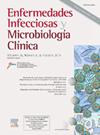长期护理机构中医疗保健相关感染的点流行研究趋势:西班牙加泰罗尼亚的一项全国性监测计划(2013-2022)
IF 2.6
4区 医学
Q3 INFECTIOUS DISEASES
Enfermedades infecciosas y microbiologia clinica
Pub Date : 2025-01-13
DOI:10.1016/j.eimc.2024.11.003
引用次数: 0
摘要
从2013年到2022年,在西班牙加泰罗尼亚的VINCat项目的97家长期护理机构(LTCF)中进行了医疗保健相关感染(HAIs)的年度点流行研究(PPS)。目的是分析HAIs和抗生素使用的趋势,以评估该地区HAIs的负担。方法比较两个5年期的PPS数据。第一阶段(2013-2017)涉及50,378名居民,第二阶段(2018-2022)涉及65,997名居民。变量包括人口特征、患者状况、PPS当日的医疗设备和最近的手术。记录HAI来源、病原微生物、抗生素及适应证。根据ECDC标准定义HAIs。结果共纳入居民116375人,年龄中位数82岁(73 ~ 88岁),女性56.7%。虽然严重依赖在第1期更为常见,但在第2期血管导尿管和导尿管的存在增加。总体而言,9943名(8.5%)居民有一个或多个hai。HAI患病率从第1期的9.3%显著下降到第2期的8%,尿路感染是这两个时期最常见的HAI,其次是呼吸道感染。大肠杆菌是最常见的微生物。不同时期的抗生素使用率没有显著差异(分别为11.8和12.1),尽管有向更有针对性的处方的转变。结论:尽管在研究期间显著减少,但加泰罗尼亚ltcf的HAIs患病率仍然很高,影响了8%的居民。高度需要实施感染预防和控制干预措施。本文章由计算机程序翻译,如有差异,请以英文原文为准。
Trends in point-prevalence studies of healthcare associated infections in long-term care facilities: A nationwide surveillance program in Catalonia, Spain (2013–2022)
Introduction
From 2013 to 2022, annual point-prevalence studies (PPS) of healthcare-associated infections (HAIs) were conducted in 97 long-term care facilities (LTCF) within the VINCat Program in Catalonia, Spain. The objective was to analyze trends in HAIs and antibiotic use to evaluate the burden of HAIs in this setting.
Methods
We compare PPS data from two 5-year periods. Period 1 (2013–2017) involving 50,378 residents and period 2 (2018–2022) involving 65,997 residents. Variables included demographic characteristics, patient conditions, medical devices on the day of PPS and recent surgery. Source of HAI, causative microorganisms, antibiotics and indication were recorded. HAIs were defined according to ECDC criteria.
Results
A total of 116,375 residents were included, median age of 82 years (range: 73–88), 56.7% female. Although severe dependency was more common in period 1, the presence of vascular and urinary catheters increased in period 2. Overall, 9943 (8.5%) residents had one or more HAIs. The HAI prevalence rate significantly decreased from 9.3% in period 1 to 8% in period 2, being urinary tract infections the most prevalent HAI in both periods, followed by respiratory tract infections. Escherichia coli was the most frequently identified microorganism. No significant differences in the prevalence of antibiotic use between periods (11.8 vs 12.1 respectively) were found, although there was a shift toward more targeted prescriptions.
Conclusion
Despite a significant reduction over the study period, the prevalence of HAIs remains high in LTCFs of Catalonia, affecting 8% of residents. Implementation of infection prevention and control interventions are highly required.
求助全文
通过发布文献求助,成功后即可免费获取论文全文。
去求助
来源期刊
CiteScore
2.10
自引率
8.00%
发文量
194
审稿时长
29 days
期刊介绍:
Hoy está universalmente reconocida la renovada y creciente importancia de la patología infecciosa: aparición de nuevos agentes patógenos, de cepas resistentes, de procesos con expresión clínica hasta ahora desconocida, de cuadros de una gran complejidad. Paralelamente, la Microbiología y la Infectología Clínicas han experimentado un gran desarrollo como respuesta al reto planteado por la actual patología infecciosa. Enfermedades Infecciosas y Microbiología Clínica es la Publicación Oficial de la Sociedad Española SEIMC. Cumple con la garantía científica de esta Sociedad, la doble función de difundir trabajos de investigación, tanto clínicos como microbiológicos, referidos a la patología infecciosa, y contribuye a la formación continuada de los interesados en aquella patología mediante artículos orientados a ese fin y elaborados por autores de la mayor calificación invitados por la revista.

 求助内容:
求助内容: 应助结果提醒方式:
应助结果提醒方式:


